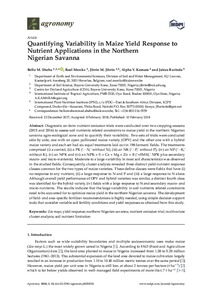| dc.contributor.author | Shehu, B.M. |
| dc.contributor.author | Merckx, R. |
| dc.contributor.author | Jibrin, J.M. |
| dc.contributor.author | Kamara, A. |
| dc.contributor.author | Rurinda, J. |
| dc.date.accessioned | 2019-12-04T11:23:42Z |
| dc.date.available | 2019-12-04T11:23:42Z |
| dc.date.issued | 2018-02 |
| dc.identifier.citation | Shehu, B.M., Merckx, R., Jibrin, J.M. & Rurinda, J. (2018). Quantifying variability in maize yield response to nutrient applications in the northern Nigeria Savanna. Agronomy, 8(2):18, 1-23. |
| dc.identifier.issn | 2073-4395 |
| dc.identifier.uri | https://hdl.handle.net/20.500.12478/4117 |
| dc.description | Open Access Journal |
| dc.description.abstract | Diagnostic on-farm nutrient omission trials were conducted over two cropping seasons (2015 and 2016) to assess soil nutrients related constraints to maize yield in the northern Nigerian savanna agro-ecological zone and to quantify their variability. Two sets of trials were conducted side by side, one with an open pollinated maize variety (OPV) and the other one with a hybrid maize variety and each set had six equal treatments laid out in 198 farmers’ fields. The treatments comprised (i) a control, (ii) a PK (‘−N,’ without N), (iii) an NK (‘−P,’ without P), (iv) an NP (‘−K,’ without K), (v) an NPK and (vi) an NPK + S + Ca + Mg + Zn + B (‘+SMM,’ NPK plus secondary macro- and micro-nutrients). Moderate to a large variability in most soil characteristics was observed in the studied fields. Consequently, cluster analysis revealed three distinct yield-nutrient response classes common for the two types of maize varieties. These define classes were fields that have (i) no-response to any nutrient, (ii) a large response to N and P and (iii) a large response to N alone. Although overall yield performance of OPV and hybrid varieties was similar, a distinct fourth class was identified for the hybrid variety, (iv) fields with a large response to N and secondary macro- and micro-nutrients. The results indicate that the large variability in soil nutrients related constraints need to be accounted for to optimize maize yield in the northern Nigerian savanna. The development of field- and area-specific fertilizer recommendations is highly needed, using simple decision support tools that consider variable soil fertility conditions and yield responses as obtained from this study. |
| dc.description.sponsorship | Bill & Melinda Gates Foundation |
| dc.format.extent | 1-23 |
| dc.language.iso | en |
| dc.subject | Zea Mays |
| dc.subject | Multivariate Analysis |
| dc.subject | Soil Nutrient |
| dc.subject | Yields |
| dc.title | Quantifying variability in maize yield response to nutrient applications in the northern Nigeria Savanna |
| dc.type | Journal Article |
| dc.description.version | Peer Review |
| cg.contributor.crp | Maize |
| cg.contributor.affiliation | Katholieke Universiteit Leuven |
| cg.contributor.affiliation | Bayero University Kano |
| cg.contributor.affiliation | International Institute of Tropical Agriculture |
| cg.contributor.affiliation | International Plant Nutrition Institute |
| cg.coverage.region | Africa |
| cg.coverage.region | North Africa |
| cg.coverage.country | Nigeria |
| cg.creator.identifier | Alpha Kamara: 0000-0002-1844-2574 |
| cg.researchtheme | PLANT PRODUCTION & HEALTH |
| cg.isijournal | ISI Journal |
| cg.authorship.types | CGIAR and developing country institute |
| cg.iitasubject | Plant Health |
| cg.iitasubject | Plant Production |
| cg.journal | Agronomy |
| cg.howpublished | Formally Published |
| cg.accessibilitystatus | Open Access |
| local.dspaceid | 99608 |
| cg.targetaudience | Scientists |
| cg.identifier.doi | https://dx.doi.org/10.3390/agronomy8020018 |

